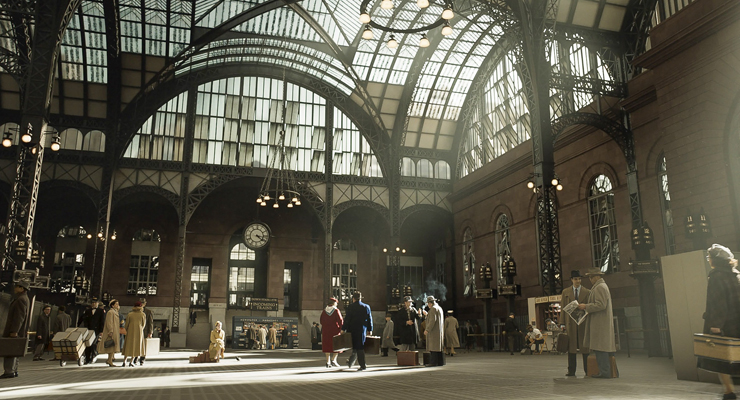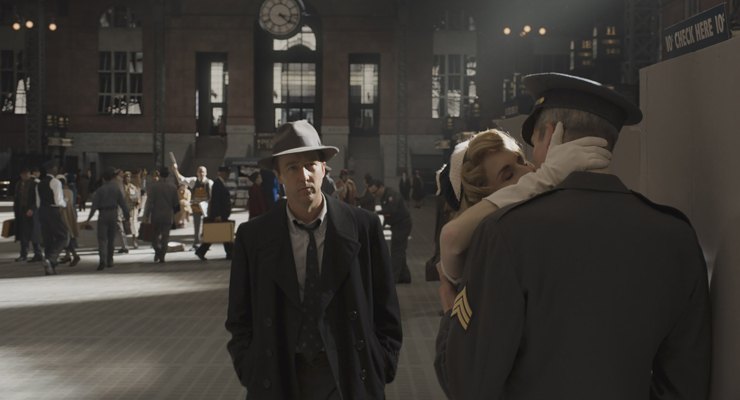NEW YORK — In Edward Norton’s new movie, “Motherless Brooklyn” (to be released Nov. 1), the year is 1957. Evocatively filmed, with an incredible jazz score, it captures the gritty New York City of that time: devoid of chain drug stores and Starbucks; with classic automobiles, buses, and trucks; period signage; and two scenes on a vintage subway train.
And a then-47-year-old Pennsylvania Station, today long gone.
The plot revolves around a mystery, with mostly fictional characters and some actual New Yorkers of the period. Norton (“Fight Club,” “25th Hour,” “American History X”) is the director and plays the lead character, Lionel Essrog, a private detective with verbal tics from Tourette’s Syndrome. Bruce Willis, William Defoe, Alec Baldwin, Gugu Mbatha-Raw, and Bobby Cannavale are the other principals who make the plot intriguing, unusual, and worth watching.
The production stayed very close to turning back the clock 62 years. It’s in the fashion, the hair styles, and the Hollywood magic recreating Penn Station, the Beaux Arts structure by architects McKim, Mead & White Beaux Arts that opened in 1910 and was torn down in 1966. Built of imported travertine marble, with 150-foot vaulted ceilings, 60-foot Corinthian columns, wide staircases, and glass floor tiles that streamed light onto the train platforms below, it was a challenging item to replicate. Visual effects supervisor Mark Russell worked with Norton to achieve the proper feel and look.
The station exists in the movie for one of its most crucial scenes, to remind everyone of the need for historic preservation — an effort which began as the last pieces of the original Penn Station were carted away to the nearby Meadowlands in New Jersey.
“The loss of Penn Station is an emotional scar that still haunts New York,” Russell said, “and an emblem of what we shouldn’t let happen again.”
In a striking juxiposition of eras, the Penn Station scenes were filmed at the former Grumman Aerospace Apollo Lunar Module assembly plant in Bethpage, Long Island. Production Designer Beth Mickle built a shoeshine stand, benches, and lockers, while Lighting Director Dick Pope designed lighting to replicate the station’s high windows. The actors performed against a giant green screen, with special effects subsequently filling in the true replication of the station.
While few color photos of the vanished landmark exist, Russell used as his base scenes from the 1955 movie “The Seven-Year Itch,” which included color scenes in the station. The 1957 version portrayed in the movie is somewhat shabby, reflecting the Pennsylvania Railroad’s need at the time to reduce spending on passengers.
Norton, Pope, and Russell utilized an NCam system, which allowed them to simultaneously use digital backgrounds and live action in real-time. This allowed the cast and crew to see a pre-visualization of the original Penn Station as they worked.
Having viewed the movie, this Trains News Wire reviewer suggests paying to see Penn Station in its original state, even if it isn’t as pristine as it was in 1910. The rest of the movie will keep you enthralled.
More information on the film is available at the Warner Bros. website.
















In 1958 I snapped a color photo of Penn Station’s interior during the morning rush hour (the large overhead clock read 9:10). The photo appears on page 45 of Don Ball’s Book “The Pennsylvania Railroad 1940s-1950s”
(Norton 1986). The station did look a little dowdy, but its soaring architecture still made it an icon of its time.
Frank Tatnall
Having strong personal memories of Penn Station in 1957, as I then lived in New York and went to college in Philadelphia, and was frequently back-and-forth, I’m looking forward to seeing how well my mind has preserved those days. I remember the obscenity of a “modern” ticketing facility, advertising everywhere, and the filth inside and out. Still, the grandeur of the building shone through, if you took the time to absorb the heroic size of it all, and imagined what it must have been when PRR was proud of it. I think it was PRR president James Symes, correct me if I’m wrong, who questioned the responsibility of a corporation to preserve a money-bleeding, tax-paying monument.